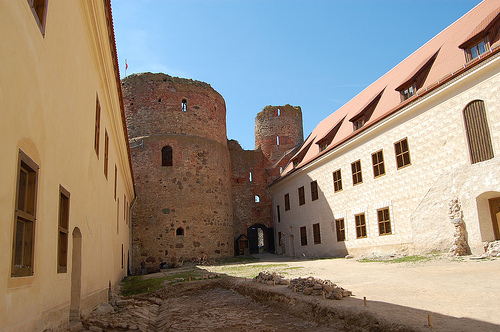

Location: Bauska, Zemgale Map
Tel. 6392 3793
Official site
Open: May- Oct: 9am- 7pm daily
Bauska Castle is a medieval fortress situated in Bauska, Zemgale region of Latvia. The military defenses are established on the confluences of Musa and Memele rivers. Strategic location of Bauska Castle have been settled since 1000 BC by the humans. In 1443 the Order of Livonian Knights established a well defended castle here to protect conquered lands. It was further remodelled in the 16th century by the first Duke of Curland, Gothard Kettler as a private residence. During the Great Northern War in 1702 the Bauska Castle was destroyed and remained in ruins until 20th century. Currently it undergoes archaeological digs and careful restoration to preserve its integrity.
History
In the 15th century, after the peace
treaty with the Grand Duchy of Lithuania, the Livonian Order gained
full control over the Bauska area and began to build a fortified
administrative center at the confluence of the Mēmele and Mūsa
confluences.
The construction of the castle began in the
period from 1438 to 1450 during the reign of Heindenreich Finke of
Oferberg, the master of the Livonian Order. The year of construction
is traditionally considered to be 1443, when the fact of
construction of the castle was mentioned in the master's letter. The
voti - the Finno-Ugric people - also took part in the construction
of the castle, who settled on the banks of the Mēmele after the
construction of the castle and were called Russians. Until the
middle of the 16th century, the castle was ruled by the Bauska
bailiffs appointed by the Livonian Order. From 1536 to 1540, the
poet Burkards Valdiss was imprisoned in Bauska Castle, who
translated 150 psalms into German and also composed melodies for
them. In 1559 Gotthard Kettler pledged the castle to the King of
Poland, in 1562 the castle became the property of the newly
established Duchy of Courland and Zemgale.
During the Duchy,
a large-scale reconstruction of the castle began and a duke's
residence was built on the site of the former forecourt, which
housed the duchy's chancellery and housed the duke's court. The duke
settled in the castle as early as 1587 and it was completed in 1596.
Along with the reconstruction, the medieval village next to the
castle was demolished. During the Polish-Swedish wars in 1625 the
castle was occupied by Swedish troops, in 1628 - by Polish troops,
in 1629 it was regained by the Duke of Courland. At the end of the
17th century, after long wars, the castle was no longer only
partially inhabited, and there were warehouses in the medieval part
of the castle.
During the Great Northern War in 1701, the
castle was occupied by Swedish troops and strong earth
fortifications were built around the castle - one of the most
expressive in the territory of Latvia. After the Battle of Mūrmuiža
and the capitulation of Jelgava, Russian Tsar Peter I sent several
regiments to occupy Bauska Castle, where only 250 men remained under
the command of Lieutenant Colonel M. G. Stel von Holstein. After a
relatively small shooting and bombing of the castle, on September
12, 1705, an act of surrender was signed, which was signed by Major
General J. Chambers. Three days after the takeover of the castle and
the city was fully completed, the Russians left Colonel Nikolai
Balck with an infantry battalion and dragoon regiment in Bauska.
Retreating in 1706, Russian troops partially blew up the castle. In
the 18th century, it was no longer inhabited and gradually turned
into ruins. In 1874, the ruins of the castle and its surroundings
became the property of the first Liven family, and a landscape park
was established around the castle.
In the 1930s, a viewing
area was built in the medieval tower of the castle. At the end of
the 1960s, it was decided to establish a local history museum in the
newest part of the castle, and the reconstruction of the castle was
started, which is still going on. The Bauska Castle Museum was
located in the reconstructed castle premises in 1990.
Description
Bauska Castle was built at the confluence of the Mūsa
and Mēmele rivers, on a narrow, rocky peninsula. A deep ditch was
dug across the peninsula in front of the castle, over which the
drawbridge led. Local dolomite, boulders and bricks were used in the
construction of the castle.
The total size of both parts of
the castle is 124 x 43 meters. The thickness of the medieval castle
walls reaches 3.5 meters. The medieval castle together with the
forecourt had five towers. The largest tower today has a viewing
area, which is 22 meters high. On the second floor level, in this
tower, there was a living room with a star vault. The buildings of
the medieval castle included a courtyard.
In the time of the
Duke, the castle included two medieval castle towers, between which
three buildings were built, which formed a new courtyard. The new
part of the castle was no longer intended for defense purposes to
such an extent, but rather played a representative role. A
characteristic element of the duke's castle is the sgrafito-style
castle plaster with illusory, drawn squares.